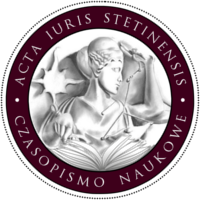






To ensure high quality and non-bias in reviewing papers published in our journal, the editors of Acta Iuris Stetinensis have designed a multi-step review procedure. All papers are subject to peer-review save for book reviews, conference proceedings, reports from training and discussion sessions and announcements of and reports from important events.
Formal assessment of papers:
• The Editorial Secretary is responsible for formal checks based on criteria outlined in Instructions for authors;
• Where a paper fails to meet any of the formal criteria, it is sent back to the author along with a note about missing or incorrect elements;
• Authors who submit papers for publications are sent a few forms to fill out: statement of the manuscript’s originality, a data processing consent form and a non-inclusive licence consent form.
Anonymity of papers:
• The Editorial Secretary removes from the text any information about the author’s/authors’ identity (file properties including).
External review:
• The Editor-in-Chief together with the Subject Editor carries out a preliminary internal review of manuscripts to see if they align with the journal’s research scope and if they are original (anti-plagiarism software is used);
• should they suspect academic fraud, plagiarism and self-plagiarism in particular, the editors, having exhausted measures of the ethics procedure, may decide to reject the manuscript and notify the author’s affiliation about it;
• selection of two external reviewers;
• the Editor-in-Chief may consult a manuscript with an expert in a given field, especially with a member of the Scientific Board.
External review:
• two external reviewers outside author’s affiliation;
• criteria for manuscript assessment: assessment of subject matter, assessment of method, assessment of substantive content, formal assessment; articles that score below 60% of maximum points will not be considered for publication; Reviewers may offer their suggestions, proposals for changes and reasons for their assessment;
• reviewers present their recommendations: accept (in current form/after substantive revision/after thorough re-editing/after completion and development of research), reject;
• reviewers as a rule will draw up their reviews within one month from receiving the manuscript;
• if in doubt, the editors will decide whether or not to publish a paper based on the reviews; a third reviewer may be asked to be involved; if at least one of the reviews recommends rejection, the manuscript will be rejected.
Presenting the review to the author:
• the review shall be presented to the author after reviewer’s information is anonymised;
• should the reviewers recommend changes, the author must revise their manuscript and address reviewer’s comments within 2 weeks.
Decision:
• should reviews recommended changes, revised manuscripts are sent back to the reviewer;
• should the reviewer or Editor-in-Chief together with the Subject Editor accept the revised manuscript (in cases where the revised text is not sent back to the Reviewer) it is sent to be published;
• should the author fail to revise the manuscript following reviewer’s recommendations or should he fail to address reviewer’s comments or should the revised manuscript be rejected by the reviewer/Editor-in-Chief together with the Subject Editor, the manuscript is rejected.
All stages of the review procedure (internal and external) are anonymous (double-blind review process), which means that the Reviewer does not know whose text they are reading and the author, even after their manuscript is accepted, does not know the identity of the reviewers.